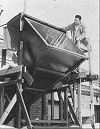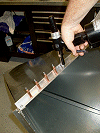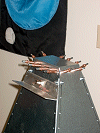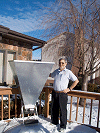|

|
|
|

|

|
This is the crude receiving equipment used by Ewen in 1951, to first detect the interstellar hydrogen line. For his efforts, Ewen received his Ph.D. His thesis advisor, Professor Edward Purcell, was later awarded the Nobel prize.
photo and diagram courtesy of Dr. Harold I. Ewen |

|

|
The radiation characteristics (gain and beamwidth over frequency) of a pyramidal waveguide horn are purely a function of its physical dimensions. Ewen thoroughly documented the physical dimensions of his horn. Reverse-engineering the Ewen horn design by analyzing its dimensions in software, we find that it exhibited nearly +24 dBi of gain at the hydrogen line, while producing symmetrical e-field and h-field beamwidths of 10 degrees.
horn dimensions courtesy of Dr. Harold I. Ewen |

|
|

|
|

|
|
 |
|

|

|
A primary design objective is that the SETI Horn of Plenty be constructed of readily available materials, with common hand tools. Before taking tinsnips to sheetmetal, a 1/12th scale mockup was constructed out of 3" by 5" index cards, to verify that all the parts would fit together properly.
SETI League photos |

|

|
The four horn sections are joined to 1" wide by 1/8" thick aluminum angle stock (sold locally at 75 cents per foot) with pop rivets. I like to place the pop rivets about a quarter wave apart at the operating frequency, which equates to about two inch spacing.
SETI League photos |

|

|
A quarter-wavelength monopole probe is used to excite the horn. It is fabricated out of a Type N flange mount coaxial connector and a 1.8 inch length of brass hobby tubing. The assembly is inserted on the centerline of the e-field horn face, 3 inches from the apex of the truncated pyramid.
SETI League photos |

|

|
Don't forget to rivet a 3 1/4" by 6 1/2" sheetmetal short at the back of the horn.
SETI League photos |

|

|
This horn design exhibits gain on a par with that of a quad helix array, a single long yagi, or a one-meter dish. However, the horn's excellent broadband impedance match, inherent lack of overspill, and low sidelobes mean its ground noise pickup will be significantly less than that of alternative antennas, providing a greater signal to noise ratio than one would expect from gain figures alone.
SETI League photos |

|
Click here for lots more pictures.
email the Webmaster | entire website copyright © The SETI League, Inc. this page last updated 22 February 2003 |
Top of Page |
 SETI League Photo Gallery
SETI League Photo Gallery
